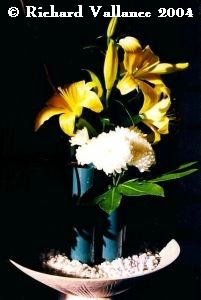|
Canadian Zen Haiku canadien Vol 2 no 3
|
|||||||
|
|
editorial
|
||||||||||
|
Editorial by Robin Ouzman Hislop How I See Haiku The Editor of Canadian Zen Haiku, Richard Vallance, has asked
me to write a few words about why I write Haiku the way I do and why I call them Haiku. I am aware Richard Vallance has taken the time and trouble
to explain this genre in the West to readers newly introduced to it over the last few decades. Richard has pointed out it
does not necessarily entail 5-7-5 syllabifies [2] to deem it a haiku. I sympathise with the dilemma. Certainly I am no expert
in its oriental tradition, and when the deck is down, neither do I place much credence in it. I recall a late famous Scandinavian
artist painter, Erling Friis, once said to me, "Why try to do what the Indians do, when they do it so much better themselves." Still, in those days, as an aspiring beatnik, I was very
impressed by the elegance of Basho´s style, a reader of Zen* and the impeccable ayats of Rumi´s Madnawi, whose calligraphy
impressed me even before I could understand them. I am aware that by the time of Basho, recent innovations in haiku brought
about significant changes from its original form. Haiku was in fact but a small segment of a larger text in a formal content.
To cut a long story short, by Basho´s day, the haikut had been transformed, adapting itself to the social environment and
philosophy of the time emerging from the influences of Mayahana Buddhism to conform more closely with the evolving Zen Philosophy,
which also was coming into vogue in the West. Oriental or Occidental? In the West, our alphabet began with phonetic syllabifies
adapted from cuneiform, functioning as letter tropes corresponding to iconographic description, which the Babylonians considered
as inferior and belonging to the lower social classes, though it was neverthless to prevail in over two thirds of the world.
In the oriental tradition numerology was adapted to iconography from the basic cuneiform quantification. Numerology was in
fact important in both traditions, even as late as in the Hebrew, where the vowel (the feminine principle) is suppressed in
the consonant inflection, while the verb retains masculine and feminine gender, and number is subordinated to the letter (gram):
Greek Pythagoreans were to reverse that construct, bringing vowels into pre-eminence, hence morphing all subsequent Occidental
languages into alphabetic scripts, beginning with Greek and Latin. The Nature of Haiku As I have already pointed out, in Basho's era (the 17th.
century), the haiku tradition had undergone some significant cultural and literary metamorphoses, and it is these that have
been translated into our modern Western alphabetical system. Both in Japan and here in the West, the haiku has still retained
its innately cryptic style and formal rigour, though it has undergone frequent readaptations since Basho's time. Traditionally and fundamentally, the first line of a haiku
sets a seasonal station, time and place, formerly based on the Japanese lunar calendar, and this modus operandi serves as
a mirror to a mood and response the haikuist wishes to evoke. Basically the concept of the Haiku is impersonal, where experience
is concretely located in nature, as a fragment, an occurrence or a transient happening where theme, object and mood are visualized
as a unity. We hear of the famous example in Zen meditation of the archer and the target, where the arrow drawn, its flight
and centre are seen as one action, in the beginning is the end, in the end is the beginning, the first in last, the last in
first, on either side neither I nor mine. To the Haiku Purists Whether this accords with Eleatic Paradoxes [2] is another
question. It appeals because of its economy of language, its rhythmic metric pattern not relying on rhyme; it is writing in
form and yet out of form, the elegance of the written word distinct from mere thought and emotion. Like the sonnet in the
Western poetic tradition, it is as if the image has a voice. In the blank verse stanzas of Western poets I often run across
tercets or 5-7-5 syllabifies. These tendencies seem to be inherited from the haiku form, as it tentatively reaches into our
alphabet world, but I find often I still want to convey more than just the articulated image, even at the cost of oocasional
abstraction, taboo to Haiku formalists, or should I say, fetishists. I want the knowledge concealed beneath the haiku form
made explicit. I see that a series of haiku can run in symphonic movements of compositions leading to dimensions of just that
kind of expressiveness, not merely the physics of the universe as seen in a grain of sand, where existence is divided by space
and time, instead of consciousness and memory. I have this to say to the scholars of Haiku
purism, I have taken its flesh and left them the bones.* * Zen Flesh Zen Bones Paul Reps * attributed to Rumi we have taken the cream
& left the bones to the scholars. Tanka Apricot petals on the dark pool fallen Robert Graves © Robin Ouzman Hislop June 2004, all rights reserved
& edited by Richard Vallance, 2004 NOTES: [1] Robin Ouzman Hislop is using the
verb "syllabify", meaning "to divide into syllables or segments" as a noun. [2] The Eleatic School was a Greek pre-Socratic philosophical school founded by Parmenides, its greatest philosopher,
at Elea, a Greek colony in Lucania, Italy. He denied the reality of change on the ground that things either exist or do not.
Accordingly, as he saw it, there can be no in-between stages, as the concept of change, or "becoming," implies, as we normally
construe these words.   |
||||||||||
 |
||





